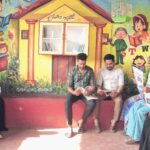As native communities around the world stare at the decline of their local language and script, here is one group of people trying to bring their mother tongue back from the brink of extinction. The Tai Phake community of around 2,000 individuals spread over nine villages in Tinsukia and Dibrugarh districts of Assam realised the threat in time. And their efforts to preserve their linguistic identity are bearing fruit.
Khammoun Chakhap, an 18-year-old schoolboy, rides a bicycle every weekend to the Buddhist monastery in his village of Namphake to stay rooted to his Tai Phake culture and language.
Set amid lush paddy fields, Namphake is located close to the Buridihing, an impetuous tributary of the Brahmaputra, which inches closer to the village and the gilded, dragon-adorned monastery each year in great waves of floods.
Chakhap studies in an English-medium school and he is bilingual like others from his small, close-knit community. They speak fluent Assamese, the lingua franca, but communicate in their native Tai language with each other.
It is widely believed that the Tai Phake migrated from Myanmar to India’s Northeast around 1775, crossing the Patkai range that forms a natural barrier between the two lands. They follow the Hinayana sect of Buddhism, like the Tai people of Myanmar, Thailand, Cambodia and Laos. The community members are mostly involved in paddy farming in the village.
“The largest village is Namphake, with around 70 households and 600 individuals. It was established in 1850,” said Gyanapal Bhukkhu, a monk.
Chakhap’s roots are the cornerstone of his identity. But ask a Tai Phake teenager to read or write Tai, and chances are they will only stumble through a few basic words and phrases. The situation is not unusual.

As with many minority languages around the world, the Tai Phake are in danger of losing their native tongue unless every one of them uses it in its all three forms — spoken, written and read. But Tai is not taught in regular schools.
Crossing the language barrier
The Tai Phake rely on family tradition and advice from monks, who mince no words when it comes to preservation and perpetuation of their language. They offered a glimmer of hope by offering to teach how to read and write in Tai.
The idea came from Paim Thee, 45, who works with All India Radio and runs Poi Foundation, a non-profit organisation based in Dibrugarh.
“Previous attempts to teach the language failed as the learners got disinterested after three-four months. So I discussed the issue with the monks, who also expressed concern. We started the Tai Phake Study and Research Centre in 2018 and the classes started next year,” said Thee.

The monks used their influence to create awareness about the importance of saving the language.
“We decided to hold the classes in a vacant government school outside the monastery,” said Bhukkhu.
Also Read | Present-day challenges to Adivasi languages
The classes are conducted by Ngi Than, 50, who uses dance and music — often turning to Bollywood numbers set in the Tai script — as an attention-holding step toward immersing the young in the language of their elders. Than is the lone instructor.
“Classes are held every Saturday and Sunday evening. There is no enrolment fee or age bar. We have around 45 students, including a few aged over 40 years. We also organise dance workshops to make the sessions attractive,” Than said, adding that the programme stopped for a year because of the Covid-19 pandemic, but it’s rolling again.
Why save the language
Languages embody the history and culture of people — the essence of their identity and their collective soul.

Experts warn that 40 per cent of the world’s smaller languages could be lost in the next few decades. There are an estimated 7,000 languages spoken around the world today, but one of them disappears about every two weeks — an alarming sign that prompted the United Nations to declare 2022-2032 as the International Decade of Indigenous Languages.
Centuries of culture
The monastery is as iconic a part of Namphake’s bucolic scenery as its library that has 300-year-old scriptures documenting the community’s rich heritage.
“The paper has not turned brittle after three centuries. We ask community members to read the books to know our legacy,” said Mahina, a monk.
In an effort to preserve old Tai texts, Paim Thee is making their digital copies. He is also documenting important Tai Phake events with videos and photographs.

Challenges are aplenty though. The younger children seldom miss classes, but the older ones do. They get bogged down by regular school studies and exams.
“We are interested in learning our script, but it becomes difficult to attend every class during exams and when there are school projects to complete. Our schools can include Tai Phake as an optional subject in the curriculum. That will help us learn the language faster,” said Ngisheng Chakhap, a Class 8 student.
The lead image at the top shows Monk Gyanapal Bhukkhu shows a chart with the Tai Phake script (Photo by Gurvinder Singh)
Gurvinder Singh is a journalist based in Kolkata.








